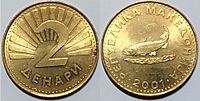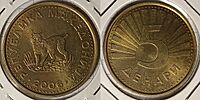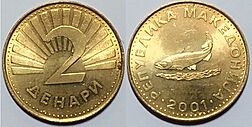Macedonian denar facts for kids
Quick facts for kids Macedonian denar |
|||
|---|---|---|---|
|
|||
| ISO 4217 Code | MKD | ||
| User(s) | |||
| Inflation | 14.2% | ||
| Source | NBRSM, 2022 | ||
| Subunit | |||
| 1⁄100 | дени (no longer used) | ||
| Symbol | den (Macedonian: ден) |
||
| Plural | denari / денари ("denars") (Macedonian: денари) |
||
| Coins | |||
| Freq. used | 1 MKD, 2 MKD, 5 MKD, 10 MKD, 50 MKD | ||
| Rarely used | 50 дени (no longer minted) | ||
| Banknotes | |||
| Freq. used | 10 MKD, 50 MKD, 100 MKD, 200 MKD, 500 MKD, 1,000 MKD, 2,000 MKD, 5,000 MKD | ||
The denar (Macedonian: денар; paucal: denari / денари; abbreviation: den / ден; ISO code: MKD) is the currency of North Macedonia. Though subdivided into one hundred deni (дени), coins with a denomination of less than one denar have not been in use since 2013.
Contents
History
The first denar was established as a temporary currency on 26 April 1992 in the then-Republic of Macedonia, replacing the 1990 version of the Yugoslav dinar at a 1:1 parity. In May 1993, the currency was reformed and a new denar was introduced, with one new denar being equal to 100 old denars.
Etymology
The name denar comes from the name of the ancient Roman monetary unit, the denarius. The abbreviation is ден, the first three Cyrillic letters of its name.
First denar (1992–1993)
The first denar was a temporary currency introduced on 26 April 1992 to replace the Yugoslav dinar at 1:1 parity and establish the monetary independence of Macedonia.
History
Macedonia declared independence from Yugoslavia on 8 September 1991. At the time, the country was using the Yugoslav dinar. But secret preparations were begun to introduce its own currency, and by April 1992, Macedonia was ready to acquire monetary independence from Yugoslavia. On 26 April, the National Bank of Macedonia was established and the denar declared the national currency. Notes in the form of "value coupons" entered circulation the following day, and on 30 April 1992, the Yugoslav dinar ceased to be legal tender. In May 1993, the first denar was replaced at a rate of 100 to 1 by a new, permanent denar consisting of notes and coins.
Coins
No coins were issued for the first denar.
Banknotes
Temporary notes ("value coupons") were introduced on 27 April 1992, although preparations for producing them began much earlier. The notes remained in circulation until they were replaced by permanent notes of the second denar in 1993.
Production
Printing of the notes started on 15 January 1992 at the “11 October” printing firm in Prilep. The difficulties of creating a new currency in secret were reflected in the notes themselves. The paper, purchased from Slovenia, proved to be of poor quality and lacked adequate security. Although denominated in denari, the name of the currency did not appear on the notes because they were printed prior to the adoption of the Law on the Monetary Unit. Likewise, the issuer appeared as the "National Bank of Macedonia", not its successor, the National Bank of the Republic of Macedonia.
Design
The notes were designed by a young employee of the "11 October" printer, who had only one week and a limited budget to design them. Thus the six lowest denominations were identical, with the exception of their colours. All featured a man and two women picking tobacco leaves on the front, with the back devoted to the Ilinden monument in Kruševo, which, according to the bank, “expresses the eternal fight of citizens of Macedonia for life in peace and freedom.”
| Banknotes of the first denar | ||||||||||
|---|---|---|---|---|---|---|---|---|---|---|
| Image | Value | Dimensions | Watermark | Description | Date of | |||||
| Obverse | Reverse | Obverse | Reverse | printing | issue | withdrawal | lapse | |||
| 10 DEN | 143mm × ? mm | Design | Women gathering tobacco | Monument Makedonium in Kruševo | 1992 | 27 April 1992 | 10 May 1993 | ? | ||
| 25 DEN | 143mm × ? mm | |||||||||
| 50 DEN* | 143mm × ? mm | 31 August 1993 | ||||||||
| 100 DEN | 143mm × ? mm | |||||||||
| 500 DEN | 143mm × ? mm | |||||||||
| 1,000 DEN | 143mm × ? mm | 30 November 1993 | ||||||||
| 5,000 DEN | 143mm × ? mm | Monument Makedonium in Kruševo | Girl in front of a computer | |||||||
| 10,000 DEN | 143mm × ? mm | Panorama of the Church of St. Sofia, Ohrid | Men dancing and the monument Makedonium in Kruševo | |||||||
These images are to scale at 0.7 pixel per millimetre. For table standards, see the banknote specification table.
|
||||||||||
Exchange rates
The denar was introduced with a fixed exchange rate of 360 denars to the Deutsche Mark.
Second denar (1993–present)
Coins
First series (1993)
In May 1993, coins for the second denar were introduced in denominations of 50 deni, and 1, 2, and 5 denars. The coins were designed by Dimče Boškoski and Snežana Atanasovska. In November 2008, 10 and 50 denar coins were introduced, while the 50 deni coin was withdrawn in 2013. Due to its low mintage, it had only been struck in 1993 and was practically never seen in circulation.
Since 1996, a large number of commemorative coins have been issued for collectors; a listing can be found on the national bank website.
Coins are minted at the Suvenir factory in Samokov, a village near Makedonski Brod.
| Coins of the denar (1993–present) | |||||||||||||||
|---|---|---|---|---|---|---|---|---|---|---|---|---|---|---|---|
| Image | Value | Technical parameters | Description | Date of | |||||||||||
| Diameter | Mass | Composition | Edge | Obverse | Reverse | minting | issue | withdrawal | lapse | ||||||
| 50 deni | 21.5 mm | 4.1 g | CuZn15 | Plain | Value, Stylized horizont with a 16-ray sun |
РЕПУБЛИКА МАКЕДОНИЈА, circular; year in the lower central field. Flying seagull | 1993 | 10 May 1993 | 1 January 2013 | Indefinitely* | |||||
| 1 DEN | 23.80 mm | 5.1 g | CuNi3Zn17 | РЕПУБЛИКА МАКЕДОНИЈА, circular; year in the lower central field. Šarplaninec shepherd dog | 1993 1997 2001 2006 2008 2014 2016 |
Current | |||||||||
 |
2 DEN | 25.50 mm | 6.2 g | РЕПУБЛИКА МАКЕДОНИЈА, circular; year in the lower central field. Ohrid trout (Salmo letnica). | 1993 1997 2001 2006 2008 2018 |
||||||||||
 |
5 DEN | 27.5 mm | 7.2 g | РЕПУБЛИКА МАКЕДОНИЈА, circular; year in the lower central field. Balkan lynx (Lynx lynx balcanicus). | 1993 1997 2001 2006 2008 |
||||||||||
| 10 DEN | 24.5 mm | 6.6 g | Cu70Ni12Zn18 | Plain | Value, Stylized horizont with a 16-ray sun |
Peacock, floor mosaic from Stobi from the 6th century AD, detail presented on the banknote of 10 Denari | 2008 2017 | 15 November 2008 | Current | ||||||
| 50 DEN | 26.5 mm | 7.7 g | Cu62Ni18Zn20 | Archangel Gabriel, fresco from the Church of St. George, Kurbinovo - 12th century, detail presented on the banknote of 50 Denari | 2008 | ||||||||||
These images are to scale at 2.5 pixels per millimetre. For table standards, see the coin specification table.
|
|||||||||||||||
Second series (2020)
Due to the country's name change as part of the Prespa Agreement, a new set of coins featuring the new name of North Macedonia is being released into circulation, starting with 1 denar coins in April 2021.
| Coins of the second series (2020–present) | |||||||||||||||
|---|---|---|---|---|---|---|---|---|---|---|---|---|---|---|---|
| Image | Value | Technical parameters | Description | Date of | |||||||||||
| Diameter | Mass | Composition | Edge | Obverse | Reverse | minting | issue | withdrawal | lapse | ||||||
| 1 DEN | 23.80 mm | 5.1 g | CuNi3Zn17 | Plain | Value, Stylized horizont with a 16-ray sun |
Република Северна Македонија, circular; year in the lower central field. Šarplaninec shepherd dog | 2020 | 1 April 2021 | Current | ||||||
| These images are to scale at 2.5 pixels per millimetre. For table standards, see the coin specification table. | |||||||||||||||
FAO coinage (1995)
In 1995, circulation coins of 1, 2, and 5 denar denominations were struck in honor of the United Nations' Food and Agriculture Organization.
Banknotes
In 1993, the new denar was issued in denominations of 10, 20, 50, 100, and 500 denar notes. The 20 denar note was only issued in this first series. In 1996, 1000 and 5000 denar notes were added. In 2016, notes of 200 and 2,000 denars were issued, while the national bank began withdrawing the 5000 denar banknote from circulation to re-balance the structure of notes in circulation. In 2017, the national bank unveiled its current polymer banknotes, the 10 and 50 denar notes, and put them into circulation on May 15.
| 1993 series (Issued October 1993) | |||||||
|---|---|---|---|---|---|---|---|
| 10 DEN | blue | Makedonium Monument in Kruševo | Panorama of Kruševo | ||||
| 20 DEN | brown-dark red | Daut-Pasha Bath in Skopje | Clock tower in Skopje | ||||
| 50 DEN | red | Monastery of St. Pantelejmon in Skopje | Old National Bank of Macedonia building in Skopje | ||||
| 100 DEN | brown | Church of St. Sofia in Ohrid | National Museum building in Ohrid | ||||
| 500 DEN | brown-dark green | Monastery of St. Jovan Caneo in Ohrid | Samuil's Fortress in Ohrid | ||||
| 1996 series | |||||||
| Obverse | Reverse | Value | Colour | Obverse | Reverse | ||
| 10 DEN | lilac | Egyptian goddess Isis (Izida, 2nd century BC), Ohrid; gold earring (4th century BC), v. Beranci, Bitola | Mosaic in Stobi (4th-5th century) | ||||
| 50 DEN | blue | Fresco in the Church of St. Pantelejmon, Nerezi; Follis coin | Arhangel Gavril in the St. Ǵorǵi Church, Kurbinovo | ||||
| 100 DEN | lilac-brown | Skopje from engraving by Jacobus Harevin | View of Skopje from an Albanian house | ||||
| 500 DEN | red-brown | Gold mask, v. Trebeništa, Ohrid (6th century BC) | Poppy flower | ||||
| 1,000 DEN | brown | Madonna Episkepis, icon from the Church of St. Vrači, Ohrid, 14th century | Gregory's gallery (14th century), Church of St. Sofia, Ohrid | ||||
| 5,000 DEN | red-brown-green | Bronze figure of Maenad (6th century BC), Tetovo | Dog and tree, mosaic, Heraclea Lyncestis (5th-6th century AD), Bitola | ||||
| Upgrade of the 1996 series | |||||||
| Obverse | Reverse | Value | Colour | Obverse | Reverse | ||
| 500 DEN | red-brown | Gold mask, v. Trebeništa, Ohrid (6th century BC) | Poppy flower | ||||
| 1,000 DEN | brown | Madonna Episkepis, icon from the St. Vrači Church, Ohrid, 14th century | Gregory's gallery (14th century), Church of St. Sofia, Ohrid | ||||
| 2014 series (Issued December 2016) | |||||||
| 200 DEN | Early medieval bronze fibula (found near Prilep); Relief of the Old Testament Psalm 41 (terracotta icon from Vinica) | Artistic elements on the façade of Colorful Mosque (Šarena Džamija, Alaca Cami), Tetovo; Marble tiles with floral designs of Isaak Beg Mosque (Isak Džamija), Bitola | |||||
| 2000 denari | Bronze artefact in the form of cup poppy (discovered in Suva Reka, Gevgelija); Macedonian bridal dress from Prilep | Decoration on the inside of a gilded bowl (16th century), "Source of Life", peacocks | |||||
| 2018 "Polymer Series" (Issued March 2018) | |||||||
| 10 DEN | lilac | Egyptian goddess Isis (Izida, 2nd century BC), Ohrid; gold earring (4th century BC), v. Beranci, Bitola. Mosaic in Stobi (4th-5th century) | Mosaic in Stobi (4th-5th century) | ||||
| 50 DEN | blue | Fresco in the Church of St. Pantelejmon, Nerezi; Follis coin | Arhangel Gavril in the St. Ǵorǵi Church, Kurbinovo | ||||
Exchange rates
The denar is de facto pegged to Euro at a rate of 1 EUR=61.3644 MKD +/- 1% using a stabilization agreement.
| Current MKD exchange rates | |
|---|---|
| From Google Finance: | AUD CAD CHF EUR GBP HKD JPY USD TRY |
| From Yahoo! Finance: | AUD CAD CHF EUR GBP HKD JPY USD TRY |
| From XE.com: | AUD CAD CHF EUR GBP HKD JPY USD TRY |
| From OANDA: | AUD CAD CHF EUR GBP HKD JPY USD TRY |
| From fxtop.com: | AUD CAD CHF EUR GBP HKD JPY USD TRY |
See also
 In Spanish: Denar macedonio para niños
In Spanish: Denar macedonio para niños
- Economy of North Macedonia
- Denarius
- Serbian dinar


